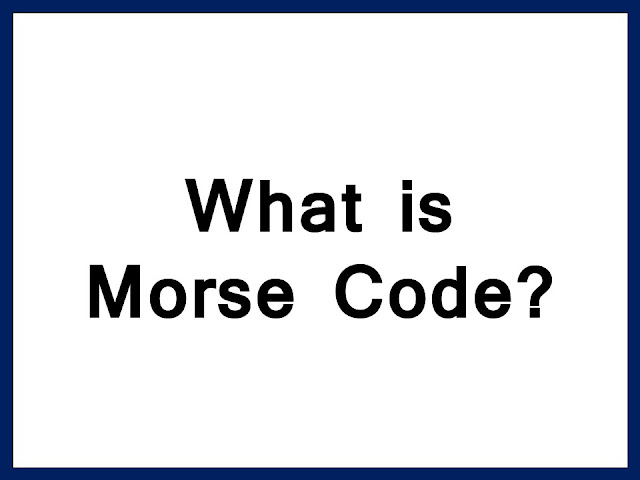Morse code is a method of encoding text characters as sequences of dots and dashes (or short and long signals), which can be transmitted via sound, light, or other means. Each letter, number, or symbol in the English alphabet is represented by a unique combination of these dots and dashes. It was widely used in telecommunication and radio communication in the past. For example, the letter "A" is represented as ".-" and "B" as "-...". Morse code is named after its inventor, Samuel Morse, and it played a significant role in early long-distance communication, particularly with telegraphy.
History of morse code
Morse code was developed by Samuel Morse and Alfred Vail in the early 1830s as a means of long-distance communication. The history of Morse code is as follows:
1. Invention and Development: Samuel Morse, an American inventor and artist, and Alfred Vail, a mechanical engineer, collaborated to create the telegraph system. Morse developed the code, which was originally called "Morse's signaling alphabet," to transmit text characters over long distances using electrical signals.
2. First Telegraph Line: In 1844, the first experimental telegraph line was built between Washington, D.C., and Baltimore, Maryland. It was on this line that Morse sent his famous message "What hath God wrought" to officially open the line.
3. International Adoption: Morse code quickly gained popularity and was adapted for use in telegraphy systems around the world. It became the international standard for telegraphy and was crucial for communication in industries like shipping and railroads.
4. Use in War: During the American Civil War and subsequent conflicts, Morse code played a vital role in military communication. Soldiers and telegraph operators used Morse code to relay important information on the battlefield.
5. Continual Use: Even with the advent of newer communication technologies like the telephone and radio, Morse code remained in use, particularly in maritime and aviation applications. It was required knowledge for radio operators and was used in distress signals, such as SOS.
6. Decline: Morse code gradually declined in use as modern communication methods became more prevalent. In 1999, the International Telecommunication Union (ITU) officially removed the requirement for proficiency in Morse code for amateur radio licenses.
7. Cultural and Historical Significance: Despite its decline, Morse code retains cultural and historical significance. It is often associated with the "beeping" sound of telegraph machines and has been featured in literature, movies, and popular culture.
Today, Morse code is primarily used for educational and hobbyist purposes. It remains an important part of the history of communication technology, showcasing the ingenuity and innovation of its inventors and its role in shaping the world of long-distance communication.
How we use morse code
Using Morse code involves representing letters, numbers, and symbols as sequences of dots (short signals) and dashes (long signals). You can transmit Morse code through sound (e.g., tapping or beeping), light (e.g., using a flashlight or signal lamp), or visual displays (e.g., flags or hand signals). Here's how to use Morse code:
1. Learn the Morse Code Alphabet: Familiarize yourself with the Morse code symbols for each letter, number, and common symbol. Here are some examples:
A: .-
B: -...
C: -.-.
D: -..
E: .
F: ..-.
G: --.
H: ....
I: ..
J: .---
K : -.-
L: .-..
M: --
N: -.
O: ---
P: .--.
Q: --.-
R: .-.
S: ...
T: -
U: ..-
V: ...-
W: .--
X: -..-
Y: -.--
Z: --..
0: -----
1: .----
2: ..---
3: ...--
4: ....-
5: .....
6: -....
7: --...
8: ---..
9: ----.
Period (.) : .-.-.-
Comma (,) : --..--
2. Transmit Morse Code:
- To send a message, use short signals (dots) and long signals (dashes).
- Pause briefly between each element and longer between each character and word.
3. Choose Your Medium:
- Sound: Tap out Morse code on a hard surface, use a telegraph key, or create beeping sounds with a device.
- Light: Use a flashlight or signal lamp to transmit Morse code with light signals.
- Visual: Use flags, hand signals, or other visual displays to send Morse code messages.
4. Practice: Like any language, Morse code requires practice to become proficient. You can use Morse code practice apps, websites, or books to improve your skills.
5. Decode Morse Code: To receive and interpret Morse code messages, you need to understand the symbols and their meanings. Listen to the signals or observe the visual displays and decode them into text.
6. Translate Text to Morse Code: To send a message in Morse code, convert the text into Morse code symbols using the Morse code alphabet. You can find Morse code charts and translators online to assist with this.
7. Start with Simple Messages: Begin with basic words and short messages to gain confidence and fluency in using Morse code.
Remember that Morse code is a simple and efficient way of communication, and it has historical significance. Whether you're learning it for a hobby, emergency situations, or historical interest, practice and familiarity with the code will help you use it effectively.
Use of morse code in today life
While Morse code is no longer a primary means of communication in today's digital age, it still has some practical and niche applications:
1. Amateur Radio (Ham Radio): Morse code proficiency is not a requirement for obtaining an amateur radio license in many countries anymore, but it remains a popular mode of communication among ham radio enthusiasts. Morse code is an efficient and long-distance communication method, especially during challenging conditions.
2. Emergency Signaling: Morse code can be used in emergency situations, particularly when other forms of communication are unavailable. Distress signals, like SOS (···---···), are recognized globally and can be used to call for help.
3. Aviation and Maritime: While not as common as in the past, some aviation and maritime communication systems still use Morse code for specific purposes, such as identifying navigational aids or beacons.
4. Historical Reenactments: Morse code is often used in historical reenactments and educational settings to showcase the technology and communication methods of the past.
5. Military and Special Forces: In some military contexts, Morse code knowledge may still be relevant, and it can be used for covert communication in specific situations.
6. Morse Code Apps and Games: There are smartphone apps and online games that teach Morse code as a fun and educational activity, keeping the skill alive for hobbyists.
While Morse code is no longer a mainstream means of communication, its historical and cultural significance, as well as its potential practical applications in certain situations, keep it relevant in today's world. It is more commonly seen as a skill or hobby, rather than a critical method of communication.










Follow Us